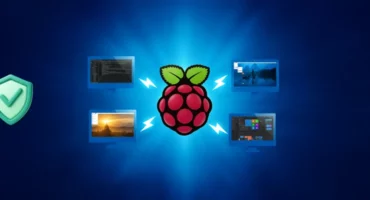What Is Bloatware? Understanding Its Impact and How to Remove It
When you buy a device from a store that hasn’t been used by anyone yet, you expect a quality product that works flawlessly. However, not all devices are ready to work correctly, even though they are new. Sometimes there is malware on the devices. It reduces the performance of the device and may distribute your data to third parties. To protect your privacy and keep the device running smoothly, you need a bloatware remover to eliminate any bloatware app that may be preinstalled. But first, a little theory.
Bloatware Explained: What It Is and Why It Exists
Since the birth of computing, humans have fought the threat of malware. But what is bloatware? This term refers to any software that infiltrates a device without your knowledge. There are many types of them, and each works differently, pursuing its own goals. However, all types of malware have two defining characteristics: they are hidden and actively work against your interests. To effectively manage your device, it is crucial to identify bloatware, which can often be recognized by its unnecessary and resource-consuming nature.
Types of Bloatware You Might Encounter
Bloatware can be categorized into several types, each affecting your device in different ways:
- Trialware: Often, when you buy a new device, it comes with trial-based software preinstalled. These are usually limited-time versions of software that third-party developers pay manufacturers to include. While they might seem useful at first, they can take up unnecessary space and can be a hassle to uninstall once the trial period ends.
- Utilities and Applications: Device manufacturers often preinstall various utilities and applications that they believe will enhance your experience. However, if you don’t use these apps, they just end up taking valuable space and resources. Some of these can be particularly stubborn to remove, making them a real nuisance.
- Adware: This type of bloatware is designed to display advertisements on your device. Adware can be particularly intrusive, compromising your privacy and security by tracking your activities. It’s often hidden and can be difficult to detect, leaving you vulnerable to cyberattacks.
- System Utilities: These are tools preinstalled by manufacturers to manage system functions. While some are essential, others might be redundant or unnecessary for your needs. Unfortunately, these can be deeply integrated into the system, making them hard to uninstall.
- Productivity Apps: Preinstalled productivity apps are meant to help you with tasks like note-taking, scheduling, and more. However, if you already have preferred apps for these tasks, the preinstalled ones just take up space and can be difficult to remove.
Why Vendors Install Bloatware
You might wonder why vendors install bloatware on devices in the first place. Here are a few reasons:
- Revenue Generation: One of the primary reasons vendors install bloatware is to generate additional revenue. By preinstalling software that displays ads or collects user data, vendors can earn money from third-party developers. This data can then be sold to advertisers, creating a steady income stream.
- Marketing: Bloatware also serves as a marketing tool. Vendors use it to promote their own products and services directly on your device. By analyzing the data collected through these apps, they can tailor advertisements and offers to your preferences, although this often comes at the cost of your privacy.
- Partnerships: Vendors often enter into partnerships with third-party developers who pay to have their software preinstalled on devices. These partnerships can be lucrative, providing vendors with financial incentives to include additional software. In return, third-party developers gain direct access to a broad user base.
How does bloatware work?
Regardless of what type of virus or preinstalled software will be on your device, they act according to the usual scheme: the user himself downloads them to the computer, without even knowing about it. On many sites, there are similar hidden programs that you click on and download occurs. For example, you click on an infected link that you received by mail or a website posted a link, ostensibly for additional information – by clicking on it, you automatically become a victim of a hacker.
Many hackers follow another principle. They distribute malware in free software downloads. For example, you want to download the Chrome browser and download it from an unknown site – the virus enters the computer. Therefore, it is essential to install the browser through the official sites. If you want to download a movie, game via torrent, you can unwittingly install a virus.
The hackers did not stop there and found another way to infect the device with viruses. They load harmful programs into the firmware of a flash drive or other USB drive. This is very tricky because the file is uploaded to the device’s internal equipment, and it does not see viruses. Therefore, if you have been provided with an unknown USB drive, do not insert it into your computer. Ask the person who gave you the USB drive to check it for viruses.
How to Identify Bloatware on Your Device?
When malware enters your device, you may notice several symptoms that your computer is at risk:
- The device is running very slowly. If your computer was running fast and suddenly started to slow down, this could indicate malware on the device. This is because malware takes over your device’s computing resources, and the computer is unable to respond to user requests quickly – it does not have enough energy.
- Less storage space. Many malicious programs are capable of installing various additional files on the computer. If yesterday you had a lot of memory, but today the storage has decreased significantly, this is a symptom that there is malware on the computer.
- Pop-ups and strange programs appeared. Once you find these two symptoms, know that there is malware in the computer, often in the form of an unwanted app. For example, when you visit a website, pop-up advertisements are displayed for you. If strange programs appeared on the desktop that you did not download, this is also a malware sign.
How to Remove Bloatware from Windows 10?
A large number of novice users are not very computer savvy. In particular, in the Windows 10 system. One of the main mistakes of such people is ignoring the antivirus, which can protect the PC from malware and other unnecessary software. If the virus has entered the system, then you need to get rid of it urgently. There are a vast number of programs and ways to combat malware, including effective bloatware removal techniques.
Install Antivirus
Of course, the first step is to install an antivirus that will prevent the most potentially harmful programs from entering Windows. When installing it, you do not have to worry about your PC being infected. Together with it, we advise you to use other cleaning programs. We can recommend such antivirus programs as Kaspersky, Avast, ESET. In addition to preventing malware, antivirus programs can help you uninstall bloatware that may be slowing down your system.
Install Additional Cleaning Programs to Uninstall Bloatware
There are many types of malicious programs, but some appear on users much more often than others. For example, when you enter any of the browsers, you are sent to another search engine or advertising site. If you can deal with the search engine by merely going into your browser’s settings and put in the “default search engine” column, you need to act differently with advertising. One of the most effective and simplest ways is to install additional cleaning programs, for example, RogueKiller. You need to go to the official website of these programs and click on the download button. After you have downloaded the programs, they will automatically find malware and ask you to confirm their removal. Using these programs can help you achieve a bloatware-free system, improving overall performance and user experience.
Using VPN and Security Tools to Avoid Bloatware
One way to bypass potential viruses is to use VPN, which creates a secure channel between the device and the Internet. With a VPN, your traffic will be encrypted and protected, which will significantly reduce the risk of infecting your computer and installing unwanted and dangerous software. Many sites can track your location, sensitive information, and other personal information. If you want to avoid information leakage, then you should use this utility. Often, bloatware comes preinstalled by the device manufacturer, making it essential to use tools like VPNs to protect your device.
Use mrt.exe
If you are the proud owner of Windows 10, you can use a unique utility built into your computer. You need to go to the “C” drive, then look for the “Windows” folder, then “System32”. Being in the last folder, in the search window, you need to enter the combination of letters “MRT.” When you search, the system will present you with several programs with the same names. You need to open the file “mrt.exe.” After that, you need to open it by simply double-clicking the left mouse button. In the window that opens, you will see the program itself, which will look like a regular explorer. The advantage of this program is that it is entirely free. You can also highlight the fact that the developer is Microsoft. That is, this software will not be able to harm Windows and will remove all viruses. This utility is particularly effective for uninstalling bloatware, ensuring your system remains clean and efficient.
How To Get Rid Of Bloatware On MacOs?
Most users may not even notice that the Mac virus is the most dangerous threat, crafted so that users cannot immediately detect them. However, suppose your Mac is behaving strangely, for example. In that case, you see applications like Advanced Mac Cleaner installed without your consent, or Google Chrome, Safari, or another browser that keeps showing you ads. Chances are you are infected with a Mac virus.
To determine if your Mac device is infected, you have to scan it with reliable security software like SpyHunter or Malwarebytes and focus on removing bloatware for good. In other cases, you can manually remove potentially unwanted programs:
- If you are in Safari or any other browser and have received a warning about malicious software, virus, then exit the browser immediately. If the browser refuses to close, then force-close the application.
- Then go to the Downloads folder and delete any installation files that will alarm you.
- If you prefer to drag the file to the Trash to replace the deletion of a file, be sure to clean the Trash.
How To Get Rid Of Bloatware On Android Devices?
Today the number of viruses and Trojans for Android is growing exponentially. Why? Hackers know that people are increasingly using smartphones and tablets as electronic wallets, and they are doing everything to move funds from the accounts of the owners to their own pockets. How can you protect your device from viruses and remove them? To protect your device from threats, it is crucial to manage and remove Android bloatware effectively.
Install Antivirus Program
Install one of the antivirus programs on your device and run a scan. There are free and paid antiviruses. Use products from well-known manufacturers. Follow the instructions of the antivirus and delete those files that it indicates as suspicious. In addition to detecting viruses, antivirus programs can help you disable bloatware that may be affecting your device’s performance.
Manually Analyze Applications
If viruses are already on the phone, they can prevent the antivirus from working correctly. Try to minimize the harm that the virus causes to your android device. Turn on Airplane mode to prevent programs from accessing the Internet. Then check the list of apps. If there are those that you do not know or have recently been installed, remove them. You can also see in the “Application manager” of the phone that they work more actively than others and consume the most traffic. You can delete app directly from the root folder on the main drive – when connected to a computer.
Limit Application Rights
You can quickly remove a virus from an Android phone if you find a malicious program in the list of “administrators” and take away its rights. To do this, go to the “Settings” menu, select the “Security” tab and find the sub-item with application rights. Also, this menu can be located in the Applications folder. Check what rights your installed applications have and restrict them if necessary. In any case, there is no need to trust third-party programs with all your secrets. The customizable nature of Android devices allows users to effectively manage and limit the rights of applications to prevent bloatware.
How To Get Rid Of Bloatware On iOS to Free Up iPhone Storage?
Viruses on iPhones are rare. However, if your device is infected with viruses, follow these steps:
- See if an update is available for iPhone. Sometimes the device crashes due to an un-updated operating system.
- Clear history and website data. Open: Preferences – Safari – Clear History and Website Data. Then click “Clear history and data” to confirm.
- Turn off your device and reboot. Hold the power button until the screen changes and a slide appears to turn off. To restart your phone, press and hold the power button again. When the Apple logo appears, you can release the power button, wait until the password entry screen appears. You need to enter your password and not use Touch ID the first time you unlock your phone after turning on the power.
- Restore your iPhone from backup. If you back up your iPhone regularly, it will be easy to restore the iPhone from the latest backup and see if the problem goes away.
- Reset iPhone to factory settings. Delete data from your iPhone: Go to Settings – General – Reset – Erase All Content and Settings, then enter your password and confirm the process. Wait for the erasing to complete and then set up the iPhone as a new device.
Managing iPhone storage effectively can help you identify and remove any unwanted applications that may be affecting your device’s performance.
Best Practices for Preventing Bloatware
Preventing bloatware from accumulating on your devices can save you time and keep your device running smoothly. Here are some best practices:
- Regularly Review Installed Apps: Make it a habit to periodically review the apps installed on your device. Identify and remove any bloatware apps that you don’t use or need. This simple step can free up space and improve performance.
- Uninstall Preinstalled Apps: Many preinstalled apps can be uninstalled. Go through your device’s app list and remove any preinstalled apps that are unnecessary. This can help you reclaim storage and reduce clutter.
- Disable or Uninstall Unnecessary System Utilities: Some system utilities might not be essential for your daily use. If you can’t uninstall them, consider disabling them to prevent them from consuming resources.
- Use Antivirus Software or Anti-Adware Tools: Installing reliable antivirus software or anti-adware tools can help you identify and remove bloatware. These tools can scan your device for unwanted apps and provide options for removing or disabling them.
Conclusion
Bloatware is a common issue that can negatively impact device performance, security, and user experience. Understanding what bloatware is and how to remove it can help you take control of your devices and ensure they operate at their best. By following best practices for preventing bloatware, you can save time and keep your devices running smoothly.
FAQ
Yes, bloatware can harm your device by consuming system resources like storage, memory, and battery life, which can lead to slower performance. Additionally, some bloatware may pose privacy and security risks if it collects data without your consent or includes vulnerabilities that cybercriminals could exploit. Removing or disabling unnecessary bloatware can improve your device’s efficiency and security.
- Choose devices with minimal pre-installed software by researching “bloatware-free” models or manufacturers.
- Opt for unlocked devices, which often have less carrier-imposed bloatware.
- Avoid installing unnecessary apps or software during setup, and carefully review permissions for pre-installed apps.
- Use tools or third-party apps to disable or remove bloatware if your device allows it.
- Bloatware refers to unnecessary or pre-installed software that takes up system resources but is not inherently harmful.
- Malware is malicious software designed to harm devices, steal data, or compromise security.
Unlike malware, bloatware is typically added by manufacturers or carriers and is often more of an annoyance than a threat.
Toggle Content
A VPN protects against bloatware by blocking malicious ads and trackers that can promote or install unwanted software. It also encrypts your online activity, making it harder for bloatware to monitor your behavior. Additionally, some VPNs offer features like ad-blocking and malware protection to stop bloatware-related threats before they affect your device.
Free bloatware removal tools can be safe, but their reliability depends on the source and developer. Reputable tools from trusted providers are generally secure, but some free options may contain ads, collect data, or even include malware. To ensure safety, research reviews, check permissions, and download only from official or well-known platforms.
VeePN is freedom
Download VeePN Client for All Platforms
Enjoy a smooth VPN experience anywhere, anytime. No matter the device you have — phone or laptop, tablet or router — VeePN’s next-gen data protection and ultra-fast speeds will cover all of them.
Download for PC Download for Mac IOS and Android App
IOS and Android App
Want secure browsing while reading this?
See the difference for yourself - Try VeePN PRO for 3-days for $1, no risk, no pressure.
Start My $1 TrialThen VeePN PRO 1-year plan






